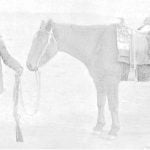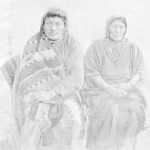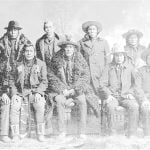Blackfeet Agency

Report of Special Agent Horatio L. Seward on the Indians of the Blackfeet reservation, Blackfeet agency, Montana, January 1891: Names of Indian tribes or parts of tribes occupying said reservation 1 Blackfoot, Blood, and Piegan.
The unallotted area of this reservation is 1,760,000 acres, or 2,750 square miles, The reservation has not been surveyed or subdivided. It was established, altered, or changed by treaty of October 17, 1855 (11 U. S. Stats, p. 657); unratified treaties of July 18, 1866, and of July 13 and 15 and September 1, 1808; executive orders, July 5, 1873, and August 19, 1874; act of Congress approved April 15, 1874 (18 U. S. Stats., P. 28); executive orders, April 13, 1875, and July 13, 1880, and agreement made February 11, 1887, approved by Congress May 1, 1888 (25 U. S. Stats., p. 113).
Indian population 1890: 1,811 2
Blackfeet Reservation

The agency, situated on Badger creek, is in a valley of the same name about 105 miles west from Great Falls on the Missouri. The reservation is about 52 miles square, with some farming lands in the western portion, but the land around the agency buildings is fit only for grazing purposes.
The Piegan are very fine looking Indians, and the police and judges are very intelligent and active in their duties.
The Mission schoolhouse, situated in Two Medicines creek about 5 miles from the agency, was built for the Jesuits by Miss Drexel, of Philadelphia, Pennsylvania. It is a substantial frame building, capable of accommodating 100 scholars. Perhaps 5 per cent of these Indians are Roman Catholics and the others are sun worshipers.
The rations issued to them consist of beef and flour, and in special cases coffee, sugar, tea, beans, bacon, and salt are provided. The government also allows the Indians yearly supplies as follows: bacon, 25,000 pounds; beans, 15,000 pounds; coffee, 12,000 pounds; sugar, 25,000 pounds; tea, 495 pounds; salt, 1,000 pounds; and, when issued, 10 to 100 rations of bacon, 3 to 100 rations of beans, 4 to 100 rations of coffee, 2 to 100 rations of salt, and 7 to 100 rations of sugar.
Everything is clean and neat about the supply house, and there are no complaints from the Indians as to their rations being insufficient. The beef is issued to them from the block. The cattle are killed and dressed as neatly as in any first-class butcher shop.
In burial of the dead, if buried at all, there is not to exceed 6 inches of earth thrown over the body. In nearly all cases, however, they are deposited in boxes on top of the ground, and 10 or 12 bodies piled up on top of each other. In one case a body was found on the top of a fence, perhaps, 6 feet above the ground. The cover of the coffin was blown off, and by removing some rocks and a small piece of cotton flannel it was found to contain the body of a child, which looked like an Egyptian mummy.
They have at this agency, inside the stockade, a very flourishing school. Some of the Indians are well advanced in reading, writing, spelling, arithmetic, geography, and drawing.
This baud belongs decidedly to the plains Indians. They are well supplied with horses, and the government furnished them last year 1,000 head of cows and 25 bulls, which will give them a good start in raising their own cattle.

Back Row: White Calf, George Steel, US Indian Agent, Tail Feather Coming over the Hill, White Grass, Joseph Kipp Mandan Trader
Front Row: Four Horns, Little Bear, Running Crane, Little Dog, Little Plume
The reservation includes many small valleys with grass in abundance, where the Indians can cut hay. The mountain streams abound in trout, and nearer the mountains to the west of the agency are deep lakes well supplied with fish. The mountains abound in game.
Near where the mission now stands, on Two Medicines creek, there is a big pile of rocks over which they used to drive the buffaloes to kill them, an Indian disguised as a buffalo acting as a decoy.
The rising generation gives promise of becoming good citizens. The children are kept in school either here or at the Sisters’ school on Two Medicines creek, and are unusually bright. They dress like white children, play with them, and are becoming accustomed-to their ways.
These Indians have not the high cheek bones which are so marked among the Cheyenne and Arapahos, but they nearly all, especially the older ones, wear the Indian blanket. The new agent is very strict with them, especially as to their use of whiskey; and he understands them, having traded among them for the past 33 years.
The agent is having a hard time with the whiskey men and the half-breeds (who are go-betweens with these whiskey men) in his efforts to break up the liquor traffic. With the assistance of the United States deputy marshals and deputy sheriffs he has succeeded in having a large number of the whiskey sellers indicted and lodged in jail at Port Benton, while others have left the country for fear of arrest. A whiskey dealer from Birch creek, who had been arrested for selling whiskey to the Indians and taken to Fort Benton, succeeded in getting bail, and the day after his arrival home he came to the agency. The agent at once sent his Indian police to bring him to his office. He then notified him to get off the reservation, and under no circumstances to come on it again without a permit.
Allotment of lands to the Piegan will be useless without the reservation of grazing lands in addition. Cattle raising can best sustain these Indians in the future.
Citations:
- The statements giving tribes, areas, and laws for agencies are from the Report of the Commissioner of Indian Affairs, 1890, pages 414-445. The population is the result of the census.[↩]
- Agent Steele reports in 1892 that there is not 1 Blackfoot on the reservation and not to exceed 6 Bloods they are Piegan who speak the Blackfeet language.[↩]


